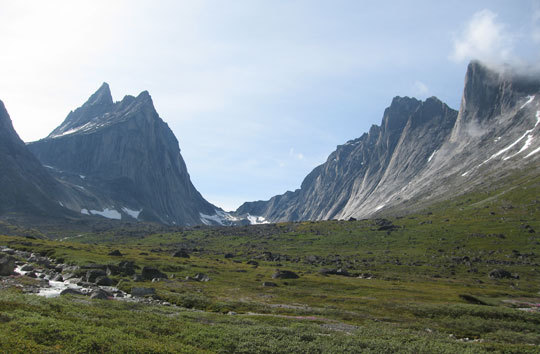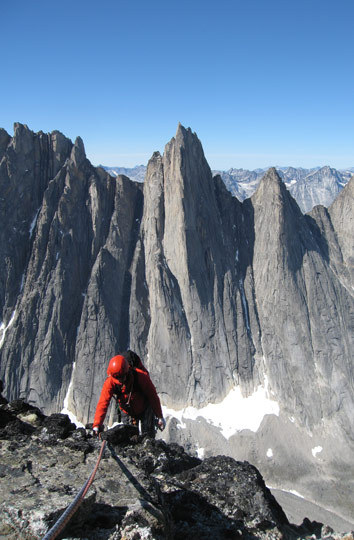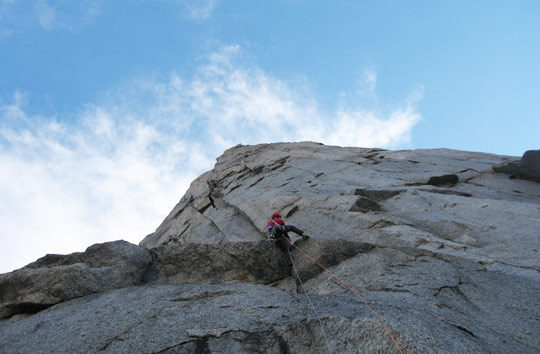
The unnamed valley south of Sermitsiaq, Greenland, in which six Brits and one Bavarian (Ruben Gutzat supposedly had never climbed trad before) established seven new all-free routes in July and August of this year. On the left is the Hermelnbjerg; on the right, the Tininnertuup group. Tininnertuup II is dolloped with a whisp of cloud, next to the left are Tininnertuup III and IV (from this angle they look like one peak), with Tininnertuup V behind. [Photo] Es Tresidder
Editor’s Note: A large group of Brits–Es Tresidder, Tony Stone, James Vybiral, Dan McManus, Tom Spreyer and Ged Desforges–and one Bavarian, Ruben Gutzat, traveled to Greenland’s Tasermiut Fjord from July 16 to August 13, 2008. Spurred by excellent weather, the group climbed numerous new, all-free lines on the fjord’s colossal granite walls–likely the most successful expedition to the unnamed valley south of Sermitsiaq in over three decades.
When we arrived in base camp below the imposing towers of the Tininnertuup group and the awesome sweep of walls of the Hermelnbjerg, only a handful of routes existed on the rock faces above us. Apart from an outstanding Irish expedition in 1971 that had climbed all the major summits of the area, the few previous expeditions had all suffered prolonged spells of unpredictable weather and required big-wall tactics and some aid. Typically each expedition had managed one route per trip, taking many days each time. We fully expected the story of our expedition to be similar. The first two days of our trip stuck to the planned script, with thick fog and drizzle greeting our arrival at the head of the Tasermiut Fjord. From then on, however, things took an entirely different direction. In the four weeks
we had at base camp, there were only three days when the weather was too poor to climb. We were very pleased to take advantage of the fine spell–we made fast ascents of seven new routes and two repeats.

Tresidder seconding a fine pitch high in “The Eye” during the first ascent of Ramblin’ Man (E5 6b [5.11d/5.12a], 1200m). [Photo] Es Tresidder collection
First off, Tony Stone, Ruben Gutzat and James Vybiral climbed a route on the unclimbed east face of Tininnertuup III on July 20. In mist for most of the way, the three climbed lots of moderate slabby ground before adding two steeper pitches of about HVS (5.8/5.9) to gain the summit ridge: Head in the Clouds (AD: HVS, 2 technical pitches, 650m). The next day Dan McManus and I set off to try the fine-looking east face of Tininnertuup II. Thinking that this would probably require big-wall tactics, we set off alpine style “just for a look” because hauling would be so obviously grim on the moderate ground characterizing the lower section of the wall. Where the wall steepened we were pleasantly surprised to find pitch after pitch of sustained climbing on excellent granite. Around fourteen hours after setting out, and after about 700m of free climbing up to E5 6a (5.11c/d), we reached the spectacular summit for a brew and a rest in the twilight before descending the Irish route back to camp. Several mosquito-ridden days later we christened our route Piriton Pillar after the copious amounts of antihistamine we were consuming. On the same day Tom Spreyer and Ged Desforges tried the superb-looking front prow on the east face of Tininnertuup III but were disappointed to find poor rock and mud-choked cracks. The pair descended from a few hundred meters up (but Tanja and Andrej Grmosovek finished the climb later in the trip).
As we arrived back in base camp at dawn after Piriton Pillar, we found Tony and Ruben packing to try Rapakivi Road (5.11 A2, 1000m) on the excellent east face of Tininnertuup IV. Twenty-five hours later, on the morning of July 23rd, after a short rest through the hours of twilight, the pair reached the pointed summit having freed every pitch onsight. They climbed a variation recommended to them by Tony Whitehouse, who was trying the route, to avoid a roof aided on the first ascent (which took seven days). An abseil descent brought them back to camp where Ruben claimed it was his first trad route. They were both raving about the quality of the route, with a crux pitch of hard E3 (5.11a) and a lot of sustained climbing at a slightly easier standard. There was a definite buzz building now at camp.
Despondent at the quality of rock they had found on Tininnertuup III, and after our stories of perfect rock on Tininnertuup II, Tom and Ged spied out a line to the left of Piriton Pillar on July 24. They were able to link features that from the ground looked improbable, and, as we had, they found superb climbing on every pitch. Tired and thinking the route was in the bag, they were instead met with an intricate and technical wall pitch followed by a fierce offwidth to gain the summit. The pair returned to base camp more enthusiastic about future possibilities, having bagged the first ascent of Scorpion Grooves (E3 5c [5.10c/d], 700m).
Back in camp James and Ruben were preparing to add another route, the Anglo-Bavarian Direct (E1 [5.10a/b], 650m) to Tininnertuup III. On July 25 they crossed Head in the Clouds and found better climbing higher up, but worse lower down. For any repeat ascensionists, they recommend the first half of Head in the Clouds combined with the top half of the Anglo-Bavarian Direct.
The same day Dan and I turned our attention to the vast west pillar of the Hermelnbjerg, where the only existing route was a Norwegian big-wall route that took the prominent chimney on the face’s left side. Our route focused on finding a way through a spectacular feature we dubbed “The Eye,” a huge circular section of very steep corners and aretes a third of the way up the wall. Our first attempt ground to a halt near the top of The Eye, after a fall for me and the realization that the way we had planned to exit was too bold. On our second attempt, on July 27, aided by the knowledge of the terrain, we were quicker and planned for the crux. Dan pulled through the roof at the top of The Eye, and we set to work on unknown ground above. After eighteen hours and around 1000m of climbing, we gained a key bivy ledge we had spied from the ground. There we melted snow, ate and slept a few hours huddled under our one sleeping bag. The following day we climbed four cold pitches up corners and chimneys to the sunny summit ridge, from where we scrambled to the west summit of the Hermelnbjerg to complete Ramblin’ Man (E5 6b [5.11d/5.12a], 1200m). The descent was made more interesting by the retreat of a glacier that had previously allowed an easy walk from the col back to camp, resulting in an additional four abseils.

McManus reaching the summit ridge on the first ascent of Ramblin’ Man. [Photo] Es Tresidder
With everyone realizing that Tininnertuup II had the best rock, two teams set off on July 31 to add more routes to this fine pillar while Dan and I enjoyed the show through binoculars from base camp. Tony, Ged and Tom climbed a superb line of corners and cracks they had spied from their previous route. At the crux Tony found desperate bridging on smooth granite and an intermittent crack offering spaced gear and holds. Ged described it as the most impressive lead he had ever seen and the normally mild-mannered Tony was moved to bellow a volley of celebratory expletives (heard from base camp!) as he pulled through the final overhang to easier ground. War Cry (E5 6a [5.11c/d], 700m) gave a further few hundred meters of superb climbing to the summit, where the trio met James and Ruben, fresh from adding their own route to the right of Piriton Pillar. Rapidly learning a thing or two about trad climbing, Ruben had swung leads with James up surprisingly bold corners and cracks in the center of a fine face to produce another Anglo-Bavarian Direct at E2 (5.10c) and 700m.
Conscious that the most spectacular summit in the area, the main summit of the Hermelnbjerg, had probably not been visited since the 1971 Irish expedition, Dan and I set off on August 3 to try and add a new route to the mountain, up the west ridge of the main summit. To gain the col we climbed four pitches up to HVS that previously would have been walking up snow (close to where we abseiled on the descent from Ramblin’ Man). We were then able to scramble to the lowest point on the ridge connecting the west summit to the main summit. Here we found evidence of previous attempts, and shortly afterward the reason for their failure: a long section of very narrow horizontal ridge that appeared to be made of gravel mixed with Weetabix; it was possible to make progress, but the rock vibrated as you moved and the whole experience was uniquely terrifying. Content with our previous efforts on this mountain, we abseiled back the way we had come and advised Tony and Ruben, who were also interested in the summit, that they would be better to try and repeat the 1971 Northeast Ridge. After a three-day spell of bad weather they set about that route, stylishly making a repeat on August 10, just before our scheduled boat pick-up from the fjord. They reported exceptional and spectacular climbing up to E1 on the ridge, and they climbed approximately 1500m to the summit in a day from base camp, bivying at the col on the way down.
The Tasermiut Fjord Expedition would like to thank the following people for their generous support of the expedition: The MEF, The BMC, The Gino Watkins Memorial Trust, Podsacs, Rab, Mountain Equipment, DMM, Mammut ropes, Lyon Equipment, Metolius, Soreen, Duerr’s jam, Jordans, Tunnocks, Sacla and The Fabulous Bakin’ Boys.

McManus starting the crux pitch of Piriton Pillar (E5 6a [5.11c/d], 700m). [Photo] Es Tresidder